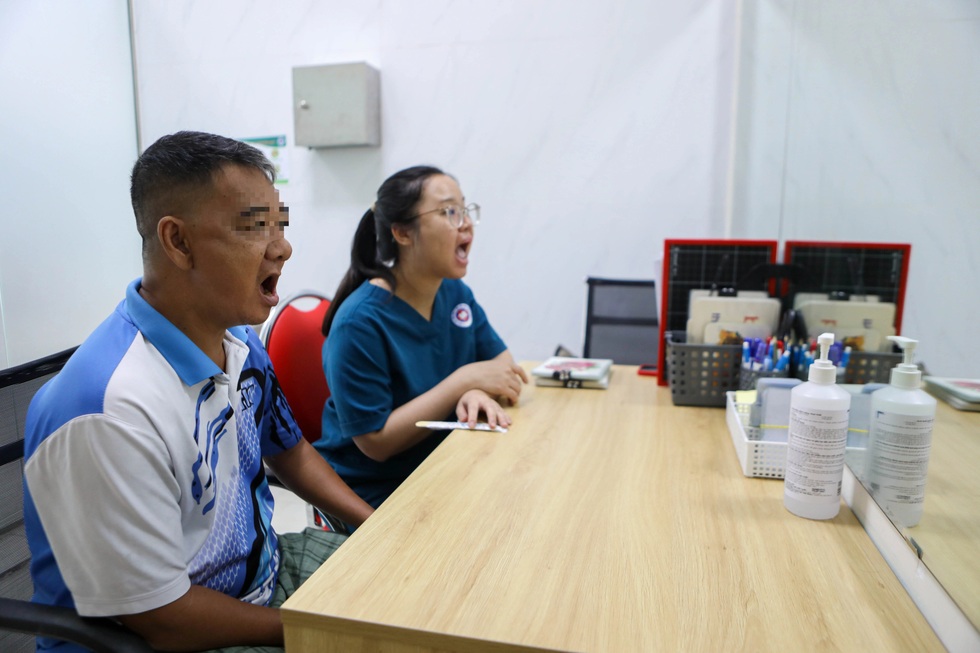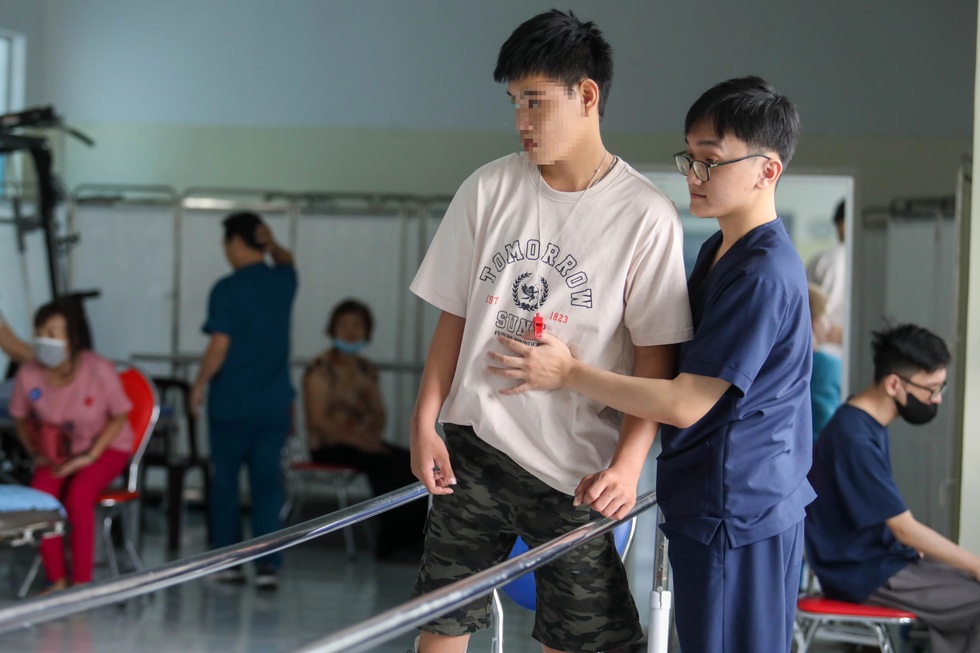Inside the speech therapy room of the Rehabilitation Department, Hospital 1A (HCMC), Mr. Phan Van Hai trembled as he opened his mouth wide, struggling to pronounce words according to the technician's instructions. In the past few weeks, he has been there almost every day, persistently practicing speaking at the age of 53.
Two years ago, the warning signs of a stroke such as slurred speech and difficulty in pronunciation appeared but he did not pay any attention. Until one day, he suddenly collapsed in the middle of work and had to be rushed to the hospital.
After waking up from the stroke, Mr. Hai, the breadwinner of the family, was completely paralyzed on the right side of his body, losing the ability to speak. Although he could still understand everything around him, he could only make vague mumbling sounds.
His recovery journey lasted nearly 2 years, from the days of physical therapy at Thong Nhat Hospital to persistent language training at Hospital 1A. Currently, he can walk with support and has started to say simple words. However, the road to rehabilitation after complications is still very long.

After stroke complications, Mr. Hai completely lost the ability to communicate normally (Photo: Bao Quyen).
Upward trend
Sharing with Dan Tri, Dr. Trinh Minh Tu, Deputy Head of the Rehabilitation Department, Hospital 1A, said that the department receives nearly 400 treatments every day, including both inpatients and outpatients. The patients are mainly people who have had a stroke, have musculoskeletal diseases or have just undergone surgery.
According to Dr. Tu, rehabilitation plays an important role in the health system, with profound humanitarian significance in helping patients regain maximum mobility, language and intelligence, while reducing the burden of care for their families.
The demand for rehabilitation is increasing in the context of a rapidly aging population, increasing chronic diseases and accidents. However, human resources are still not enough to meet the demand, especially in intensive rehabilitation specialties such as speech therapy and occupational therapy.
“There are cases where patients have to schedule training sessions every other day instead of every day due to a lack of specialists and intensive rehabilitation technicians. Doctors are forced to take on many tasks and work at high intensity to avoid treatment interruptions, otherwise it will directly affect the patient's recovery process,” Dr. Tu shared.

Patients practice motor rehabilitation with walking robots (Photo: Bao Quyen).
Serious shortage of PHCN human resources
The shortage of rehabilitation personnel is not only happening at Hospital 1A but is also a common problem in Ho Chi Minh City. According to MSc. Le Thi Ha Quyen, Department of Rehabilitation, Ho Chi Minh City Hospital of Rehabilitation and Occupational Disease Treatment, the whole city (before the merger) had only 47 rehabilitation specialists.
Meanwhile, each year, the University of Medicine and Pharmacy in Ho Chi Minh City only trains about 30 students for the first, second and residency programs. This small number must be distributed to all provinces and cities, causing Ho Chi Minh City to fall into a serious state of "thirst" for human resources.
For physical therapists, the supply is relatively stable with about 200 graduates each year, as this is a major that has been widely trained for decades. In contrast, occupational therapists are currently only trained at the University of Medicine and Pharmacy in Ho Chi Minh City, with about 30 graduates each year.
The community-based rehabilitation program, although implemented by the Ministry of Health for nearly 30 years, still faces many difficulties when applied in Ho Chi Minh City due to the large and complex geographical characteristics.
In addition, according to Dr. Trinh Minh Tu, specialized fields such as speech therapy, occupational therapy or psychotherapy are not yet widely taught in medical schools. Current programs mainly rely on international cooperation, leading to a very limited number of output human resources.
A 2020 report by the Ministry of Health shows that the rate of primary health care workers in Vietnam is only about 0.25 people/10,000 people, much lower than the recommendation of the World Health Organization (0.5-1 person/10,000 people).

Currently, PHCN human resources in Vietnam still have many limitations (Photo: Bao Quyen).
Explaining the reason, Dr. Vo Van Long, Head of the Day Treatment Unit, University of Medicine and Pharmacy Hospital, Ho Chi Minh City (Campus 3), said that the income, promotion opportunities and social recognition for the PHCN profession are still not commensurate with the role. This is the reason why many young people do not choose to pursue the profession, despite the great actual demand.
This situation leads to one medical staff being in charge of too many patients, making treatment regimens prone to massification and lack of close monitoring. As a result, the patient's recovery process is significantly affected.
Need many synchronous solutions
To overcome the shortage of human resources and improve the quality of rehabilitation services, experts say it is necessary to synchronously deploy many solutions.
According to Dr. Trinh Minh Tu, medical universities need to expand the scale of training in rehabilitation, especially focusing on narrow specialties such as physical therapy, speech therapy, occupational therapy and psychotherapy.
Adding his point of view, Dr. Vo Van Long said that the State and medical facilities must develop a reasonable salary and allowance system, while creating a safe working environment and career development opportunities. When medical staff feel appreciated, they will stay longer and contribute more.
Vietnam can also learn training and practice models from advanced countries, and invite international experts to teach on-site. This is considered the fastest way to improve the quality of human resources.
In addition, when society understands the role of PHCN correctly, the increased demand for services will become a driving force to attract many young people to choose the industry. Widespread communication also helps the patient's family to cooperate more actively in the training process.
“Personal rehabilitation is the ‘extended arm’ of medicine, helping patients not only escape from illness but also live healthy, independent lives and integrate into the community. However, for this field to fully play its role, it needs synchronous attention from the State, training institutions, hospitals and the community. Only when a sustainable human resource development strategy is built with appropriate remuneration policies, can the rehabilitation industry meet the growing needs of society,” Dr. Long emphasized.
Source: https://dantri.com.vn/suc-khoe/nghich-ly-phuc-hoi-chuc-nang-o-viet-nam-20250924121246857.htm







![[Photo] National Assembly Chairman Tran Thanh Man attends the inauguration ceremony of the Memorial Site of National Assembly Standing Committee Chairman Bui Bang Doan](https://vphoto.vietnam.vn/thumb/1200x675/vietnam/resource/IMAGE/2025/9/28/6feba23492d14b03b05445dd9f1dba88)



























































































Comment (0)